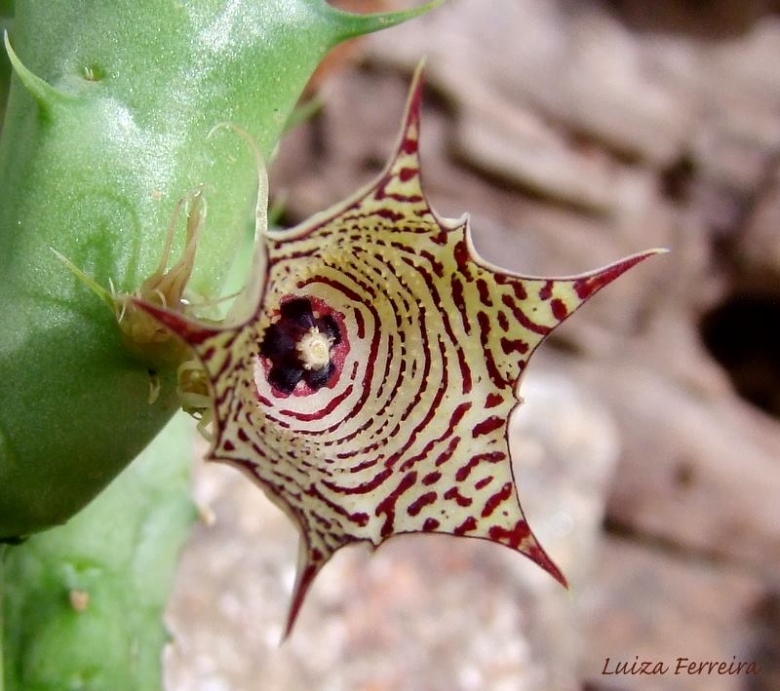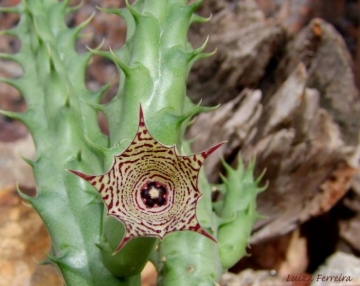
Huernia macrocarpa subs. concinna Photo by: Luiza Ferreira
Origin and Habitat: Huernia concinnaSN|21267]]SN|21267]] appears to be an extremely rare species known for a long time only from the type collection; It originally collected by Mrs. Lort-Phillips in 1896 in Somaliland, it has not been found again despite considerable collecting activity of recent years by John Lavranos and others in the same area. But the plant seems diffused in Ethiopia and Somalia.
Altitude range: Around 1500 metres above sea level.
Synonyms:
See all synonyms of Huernia macrocarpa
Description: Huernia macrocarpaSN|21267]]SN|21254]] subsp. concinna, often labelled Huernia concinnaSN|21254]]SN|21267]], is a tufted, perennial succulent distinguished by pale sulphur-yellow flowers marked all over with small dark brownish-crimson spots, as opposed to Huernia macrocarpaSN|21267]]SN|21254]] that has dark purple flowers with recurved petal tips.
Stems: Decumbent, 2.5-6 cm long, 9-10 (or more) mm thick, exclusive of the teeth, 5-angled, glabrous, light green, scarcely glaucous. Ribs toothed; teeth 6-7 mm long, straight, spreading, subulate from a stout conical base, without lateral teeth.
Flowers: 1–2 or more, fascicled on the basal part of the young stems. Pedicels 5 mm long, glabrous. Sepals 8 mm long, 1.5 mm broad at the base, gradually tapering to very fine hair-like points, glabrous. Corolla, campanulate, about 25 mm in diameter, outside glabrous, smooth, whitish; inside everywhere covered with little bristle-like processes, pale sulphur-yellow, marked all over with small dark brownish-crimson spots, narrowly margined with dark purple-brown on the lobes, not ciliate. Tube about 6 mm long and 14 mm in diameter, broadly campanulate. Corolla lobes 8 mm long, 9 mm broad, slightly spreading, broadly triangular, acuminate. Corona c. 3.5 mm wide.Outer corona very shortly 5-lobed, rich velvety purple-brown; lobes 0.5 mm long, 1.3-1.5 mm broad, transversely oblong, emarginate; inner coronal-lobes 1 mm long, 0.7 mm broad at the base, gradually tapering to a subobtuse point, connivent in a cone over the tips of the anthers, yellow, margined and speckled with purple-brown.
Taxonomy note: Huernia concinnaSN|21254]]SN|21267]] is an inexplicably confused species differently assessed in different publications. According to Schumann, this plant is the same as Stapelia macrocarpaSN|21255]]SN|21255]] A. Rich. By the other hand N.E. Brown's original description in Flora of Tropical Africa, vol. 4 (1903), it is explicitly stated that it was "Described from a living plant brought from Somaliland by Mrs. Lort-Phillips. There is therefore no doubt whatsoever that the Lort-Phillips specimen is the holotype in terms of I. C.B.N. (1983), Art. 7.3. Unfortunately N.E. Brown included H. macrocarpa sensu Taubert (1895) in the synonymy of his new species, and it is evident, that in consequence, the majority of authors have accepted his H. concinna (1903) to be the publication of a new name for Taubert' s plant, and that the I. C.B.N, required the acceptance of H. macrocarpa sensu Taubert (1895) as the type of H. concinna N.E.Br. Gilbert (1975) treated H. concinna as a subspecies of H. macrocarpa distributed also in Ethiopia. This taxonomy was rejected by Leach (1988), who treated H. concinna as a Somali endemic totally unrelated to H. macrocarpa, and Gilbert then placed the Ethiopian material of his subsp. concinna in the newly described H. macrocarpa subsp. harerghensis M.G. Gilbert (2003). However, a new investigation in 2004 shows that Gilbert (1975) was probably right and that H. concinna indeed occurs in Ethiopia and is the same as H. macrocarpa subsp. harerghensis.
Bibliography: Major references and further lectures
1) Focke Albers, Ulrich Meve “Illustrated Handbook of Succulent Plants: Asclepiadaceae: Asclepiadaceae” Volume 4 Springer, 2002
2) L. C. Leach “A Revision of Huernia R. Br. (Asclepiadaceae)” Aloe, Cactus and Succulent Society of Zimbabwe, 1988
3) Huernia concinna in: Excelsa, Edizioni 7-12, Aloe, Cactus and Succulent Society of Rhodesia, 1978
4) N. E. Brown. “Flora of Tropical Africa” Vol 4, Part 1, (1904)
5) M. Gilbert, D. Goyder, J. Lavranos, S. Liede-Schumann, M. Thulin, and J. Venter. "Flora Somalia", Vol 3, (2006) [updated by M. Thulin 2008]
 Huernia macrocarpa subs. concinna Photo by: Luiza Ferreira
Huernia macrocarpa subs. concinna Photo by: Luiza FerreiraSend a photo of this plant.The gallery now contains thousands of pictures, however it is possible to do even more. We are, of course, seeking photos of species not yet shown in the gallery but not only that, we are also looking for better pictures than those already present.
Read More... Cultivation and Propagation: Huernia macrocarpaSN|21267]]SN|21254]] subs. concinna is an easy obliging blooming plant when mature, that it is happy in any average succulent house.
Spring: When winter ends and they begin to grow again, they will require much water and soaking the pots will no longer put the plants at risk for rot. In the spring they will grow well in partial shade and leaving them out in the rain may provide them with the water they need.
Summer: In the summer months they will tolerate heavy rain, but will be just as happy if the season is dry. It's best to sort out the stems while the plants are resting in the summer before they begin their autumnal growth cycle. They will tolerate very hot weather outdoors as long as they are kept in filtered light and this will encourage them to flower in the Autumn. They also enjoy some fertiliser. Moving the plants as they are developing buds may cause them to spontaneously abort the flowers all together.
Autumn: In the fall keep them outdoors until the night time temperatures drop below the 10°C.
Winter: Winter care presents no problems at 10° C with plenty of light. As soon as they are flowered be sure to take extra precautions to keep them dry, because damp cool conditions when the plants are resting is an invitation to fungal infections, but - according to temperatures –some occasional lit watering may be useful.
Potting medium: Since roots are quite shallow, use a cactus mix or add extra perlite or pumice to regular soil potting soil. A gritty, very free-draining compost is suitable, and clay pots help the plants to dry out between watering. Re-pot every 2 years.
Pest and diseases: Huernia are generally fairly easy to grow, especially if kept pest-free. They are very susceptible to stem and root mealy bugs, and damage from these may well initiate fungal attack. Any time when there is a dead or dying stem in the pot it is important to remove it immediately and completely before other healthy stems can become ill too, isolate the healthy parts, dry them off, and re-root them in new compost.
Traditional uses: The crushed leaves of Huernia concinnaSN|21254]]SN|21267]] N.E.Br. from Ethiopia and Somalia are used in Ethiopia as a dressing to reduce swellings.
Propagation: Easiest with stem cuttings. Allow cuttings to dry a day before planting. Stems must be laid (Not buried) on gritty compost and will then root from the underside of the stems. It can also be increased from seeds sowing in spring in moist, sandy peat moss. Barely cover seeds. Seeds germinate quickly.
In any season it's best to lay the stems out for several days before replanting them and then pot them only in dry soil and withhold any water until they begin to shrivel or start growing again.












